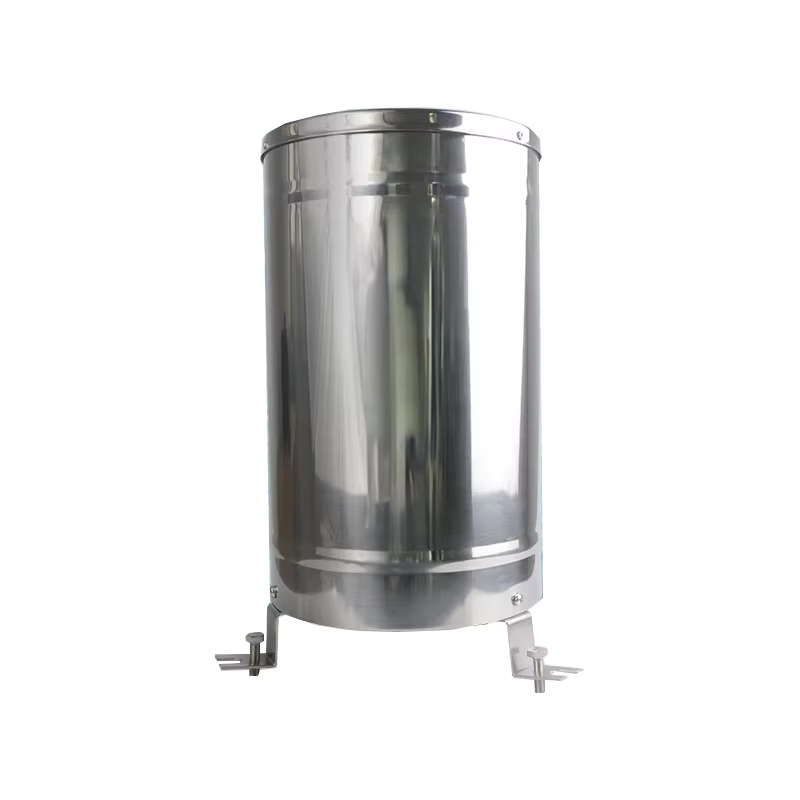नए स्टेनलेस स्टील वर्षामापी तूफानों और टाइफून में स्थिर प्रदर्शन प्रदर्शित करते हैं, जिससे सटीक मौसम संबंधी डेटा संग्रह संभव होता है
17 जून, 2025
तीव्र वैश्विक जलवायु परिवर्तन और लगातार होने वाली चरम मौसम घटनाओं की पृष्ठभूमि में, पारंपरिक वर्षा निगरानी उपकरण अक्सर भारी बारिश, तेज़ हवाओं और नमक के छींटों के दौरान जाम और जंग लगने से ग्रस्त हो जाते हैं, जिससे डेटा में अशुद्धि होती है। हाल के वर्षों में, स्टेनलेस स्टील के वर्षामापी उपकरण मौसम विज्ञान, जल विज्ञान और आपदा निवारण में एक क्रांतिकारी बदलाव के रूप में उभरे हैं, जो उनके अवरोध-रोधी डिज़ाइन और बेहतरीन संक्षारण प्रतिरोध के कारण है, जो उन्हें चरम मौसम निगरानी के लिए अपरिहार्य उपकरण बनाता है।
1. अवरोध-रोधी डिज़ाइन: भारी बारिश और मलबे से निपटना
भारी बारिश के दौरान, पारंपरिक वर्षामापी अक्सर पत्तियों, गाद और अन्य मलबे से अवरुद्ध हो जाते हैं, जिसके परिणामस्वरूप माप त्रुटियाँ होती हैं। नए स्टेनलेस स्टील वर्षामापी (जैसे हेबेई फीमेंग इलेक्ट्रॉनिक का FM-YLC1 RS485 वर्षा सेंसर) में एक विशेष जालीदार फ़नल डिज़ाइन होता है जो अशुद्धियों को प्रभावी ढंग से फ़िल्टर करता है, जिससे माप प्रणाली में पानी का सुचारू प्रवाह सुनिश्चित होता है। उच्च-स्तरीय मॉडलों में रखरखाव की ज़रूरतों को कम करने के लिए यांत्रिक कंपन या जल फ्लशिंग तकनीक का उपयोग करते हुए स्व-सफाई सुविधाएँ भी शामिल हैं।
2. संक्षारण प्रतिरोध: अम्लीय वर्षा और नमक स्प्रे को सहन करने में सक्षम
तटीय क्षेत्रों और उच्च प्रदूषण वाले औद्योगिक क्षेत्रों में, वर्षा जल में अक्सर लवण या अम्लीय यौगिकों का उच्च स्तर होता है, जिसके कारण साधारण धातु के वर्षामापी समय के साथ जंग खा जाते हैं और खराब हो जाते हैं। स्टेनलेस स्टील के वर्षामापी (जैसे, बीजिंग कैक्सिंग डेमाओ का टीबी-वाईक्यू मॉडल) 304/316 स्टेनलेस स्टील से दर्पण पॉलिशिंग या निष्क्रियता उपचार के साथ बनाए जाते हैं, जिससे स्थायित्व में उल्लेखनीय वृद्धि होती है और अम्लीय या अत्यधिक आर्द्र वातावरण में भी सटीक माप सुनिश्चित होता है।
3. अत्यधिक तापमान अनुकूलनशीलता: -50°C से 80°C तक स्थिर संचालन
उत्तरी क्षेत्रों के ठंडे इलाकों या दक्षिणी जलवायु में, प्लास्टिक के वर्षामापी यंत्रों में दरार पड़ने और पुराने होने का खतरा रहता है। इसके विपरीत, स्टेनलेस स्टील के वर्षामापी यंत्र (जैसे झेजियांग शेंगडी इंस्ट्रूमेंट के MKY-SM1-1) -50°C से 80°C तक के तापमान में मज़बूती से काम करते हैं, जिससे पहाड़ों, रेगिस्तानों और ध्रुवीय क्षेत्रों जैसे चरम वातावरण में भी निर्बाध डेटा संग्रह सुनिश्चित होता है।
4. स्मार्ट मॉनिटरिंग + कम रखरखाव: आपदा निवारण को बढ़ावा
IoT तकनीक से एकीकृत, कुछ स्टेनलेस स्टील वर्षामापी (जैसे, FM-YLC1 मॉडल) RS485 डेटा ट्रांसमिशन का समर्थन करते हैं, जिससे बाढ़ की चेतावनी और शहरी जलभराव नियंत्रण के लिए क्लाउड प्लेटफ़ॉर्म पर वास्तविक समय में वर्षा डेटा अपलोड करना संभव हो जाता है। इनका कम रखरखाव वाला डिज़ाइन (केवल समय-समय पर जाली की सफाई की आवश्यकता होती है) श्रम लागत को काफी कम कर देता है, जिससे ये दूरस्थ स्वचालित मौसम केंद्रों के लिए आदर्श बन जाते हैं।
5. बाज़ार के रुझान: स्टेनलेस स्टील रेन गेज का तेज़ी से विकास
उद्योग के पूर्वानुमान बताते हैं कि वैश्विक वर्षा निगरानी उपकरणों का बाजार 2025 तक ¥1 बिलियन (USD 140 मिलियन) से अधिक हो जाएगा, और स्टेनलेस स्टील के वर्षामापी उपकरण अपनी टिकाऊपन और लंबी उम्र (10+ वर्ष) के कारण मौसम विज्ञान और जल संसाधन एजेंसियों के लिए प्राथमिकता बन जाएँगे। चीन और दक्षिण पूर्व एशिया में, जहाँ भारी वर्षा अक्सर होती है, इसकी माँग विशेष रूप से प्रबल है। भविष्य में होने वाली प्रगति में आपदा प्रतिक्रिया क्षमताओं को और बेहतर बनाने के लिए AI-आधारित वर्षा पूर्वानुमान को एकीकृत किया जा सकता है।
निष्कर्ष:
बढ़ती जलवायु चुनौतियों के दौर में, उच्च-सटीक, विश्वसनीय मौसम निगरानी उपकरण अत्यंत महत्वपूर्ण हैं। स्टेनलेस स्टील के वर्षामापी, अपनी अवरोध-रोधी, संक्षारण-रोधी और चरम-मौसम-रोधी विशेषताओं के साथ, धीरे-धीरे पारंपरिक मॉडलों की जगह ले रहे हैं और स्मार्ट जल प्रबंधन और आपदा न्यूनीकरण प्रणालियों के मुख्य घटक बन रहे हैं। जैसे-जैसे पदार्थ विज्ञान और IoT तकनीकों का अभिसरण जारी रहेगा, उनके अनुप्रयोगों का विस्तार होगा और वैश्विक मौसम संबंधी निगरानी के लिए और भी अधिक मज़बूत समाधान उपलब्ध होंगे।
कृपया होन्डे टेक्नोलॉजी कंपनी लिमिटेड से संपर्क करें।
Email: info@hondetech.com
कंपनी वेबसाइट:www.hondetechco.com
फ़ोन: +86-15210548582
पोस्ट करने का समय: 17 जून 2025


